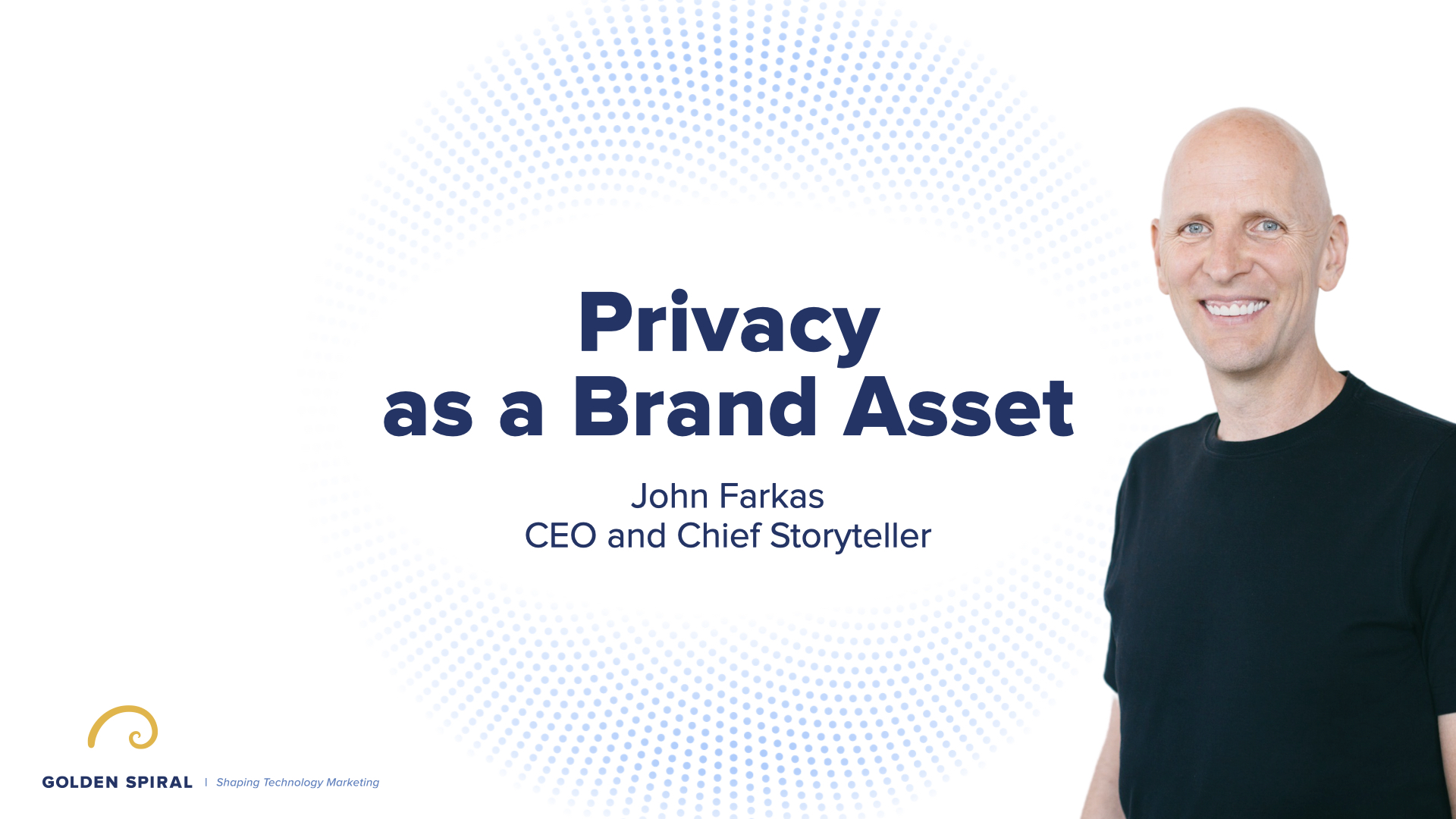Privacy as a Brand Asset

Golden Spiral CEO John Farkas presented this material at OpenMined‘s 2020 Privacy Conference.
If your company touches AI at all, you are touching customer data. Preserving your customer’s privacy while extracting meaning from the data is a difficult proposition.
How are you wrestling with your customer data and privacy? You may not be running point on privacy for your company, but you know who is. Pass this on.
In this message, John discusses how to foster an environment where privacy can emerge as a brand attribute for your organization and make privacy a value.
Think About This
Privacy is a human right.
81% of Americans express concerns regarding companies collecting private data.
86% of US citizens have attempted to remove or decrease their online presence.
21% of email and social media users have experienced at least one cyberattack.
66% of Americans believe the government should collect some data.
An adapted transcript
Introduction
(0:00) Greetings everyone. What I’m going to share with you is essentially:
The outline of the steps that need to happen to bring privacy forward as an asset for your brand.
And I’m out here on this highway under construction, because what we’re talking about here is a journey. It takes a lot of work to get there, but with some commitment and well pointed effort, you’re going to be able to leverage a strong product value proposition with an emphasis on privacy to propel your brand forward in meaningful ways.
 And because we’re out here on this road, I’m going to start with a little story about my first journey. I was born at the end of the baby boom and the beginning of the Xers in December of 1964. Now, for your reference, that’s the year 11 BDC. BDC, you know, before desktop computers, in the year 12 BDC. My dad bought one of these right off the lot, the 1963 Rambler Ambassador 880, not exactly a design triumph, but it was the first car I ever rode in.
And because we’re out here on this road, I’m going to start with a little story about my first journey. I was born at the end of the baby boom and the beginning of the Xers in December of 1964. Now, for your reference, that’s the year 11 BDC. BDC, you know, before desktop computers, in the year 12 BDC. My dad bought one of these right off the lot, the 1963 Rambler Ambassador 880, not exactly a design triumph, but it was the first car I ever rode in.
In in fact, my earliest vivid memories are in the backseat of that car, which looked pretty much exactly like this. And you may ask, how do I remember what that car looked like? So clearly, well, if you look at the pictures, there’s something missing: seatbelts. I crawled, slobbered, and spilled all over that backseat.

And I remember jumping on it like a trampoline, looking out the back window and waving at the cars behind as my parents drove around the city oblivious to what we need now see as the insane danger. Looking back on it, it wasn’t saying death by vehicle numbers between 1964 and 1968 in the years I was bouncing around that backseat were among the highest in history. Today’s numbers, even with faster cars on more crowded highways, are about 60% lower. Now the people who invented seatbelts understood that the cars that they were selling were killing their customers, and eventually a problem like that is going to get noticed.
 And that is exactly what happened in 1965. When Ralph Nader published this book, Unsafe at any Speed. Now most of you are likely too young to have come across it, but it ignited a firestorm that was the catalyst for accountability, new safety standards, testing, and other reforms in the U.S. automotive industry that ended up being rolled into the National Traffic Safety and Motor Vehicle Act.
And that is exactly what happened in 1965. When Ralph Nader published this book, Unsafe at any Speed. Now most of you are likely too young to have come across it, but it ignited a firestorm that was the catalyst for accountability, new safety standards, testing, and other reforms in the U.S. automotive industry that ended up being rolled into the National Traffic Safety and Motor Vehicle Act.
Now over the last decade, AI has evolved into an unsafe vehicle, speeding down the road with its passengers, gleefully unaware that they are fundamentally unsafe.
Now five to seven years from now, I think they’re going to look back on today and wonder how in the world we existed with the haphazard privacy frameworks and lack of ability to safely access and benefit from meaning and data without compromise. A rough equivalent to the national traffic motor safety vehicle act has been GDPR.
It’s been a loud wake up call for a lot of companies who have been playing fast and furious with customer data. GDPR was seen by many as a nasty obstacle, and it was for those exploiting data without regard for the people that it’s tied to.
But here’s what I want you to know:
There’s a real opportunity right now for those companies willing to go for it, to emerge as the leader in the new era for care and sensitivity around customer data.
Now, if you’re attending these sessions, you are a data privacy pioneer. You’re already thinking ahead of at least 98% plus of the market about how to care for and protect customers’ interests. Now at the heart of an organization that advocates for privacy is the fundamental belief that customers’ interests come first. And that’s a really smart place to be, but it seems to be increasingly uncommon.
And here’s why there is so much available capital we’re living in a time of practically unlimited funds, relatively speaking, right? Anyway, companies once actually had to live by the metrics of basic unit economics. They had to work to ensure their customers were thriving and happy with their products. But, now we’re living in this free money fantasy, and a company’s focus is totally fragmented. They have to make sure that they’re pleasing investors, media, analysts, regulators, then maybe customers; it’s optics over output. And let me tell you, the market’s getting really tired of being led down blind alleys lined with fake claims, promises, vaporware, and empty and little regard for any of the fallout. Ever heard of Theranos anyone? The markets getting tired and wise to the sense of being explored. We need seat belts and the market is starting to demand it. So, our agency, Golden Spiral, helps bring B2B SaaS solutions to market.
Our team often gets the chance to interview our clients’ customers about their needs and a common thread is emerging. Their customers want to know, “How are you going to respect my data? Not just do you respect my data, but specifically, how are you going to do it? What measures are you putting in place to safeguard by customers as you dive in and operate on my data sets? Because we cannot be compromised.” The answer is a lot of organizations are able to give to those questions right now are lacking substance. It’s an opportunity.
So let’s explore the outline of those steps that need to happen to bring privacy forward as a brand asset. It’s a collection of wisdom and input from Forrester, Sirius Decisions, and our team at Golden Spiral. And this is decidedly condensed fly-by of what is an unavoidably a deep involved process.
But every step here is critical. Don’t be tempted to shortcut the process. Don’t do it.
Preliminary qualifier: a DNA belief that doing the right thing for your customers is the best way to go
It’s great for business. And as I said earlier, that’s no longer a given. James Clear, the author of New York Times bestseller, Atomic Habits, recently tweeted:
“Businesses succeed when the self-interest of the business is aligned with the self-interest of the customer.”
So if that’s true of your organization, then you can go to the next step. If not, if loyalty and your company goes first to investors or shareholders, then you have to fix that problem before you can move any further. And unfortunately, it’s hard to do if you’re anywhere, other than in the C-Suite. Be realistic here. It’s really unusual to change the DNA of a company unless you’re leading it, it can happen, but it’s really, really rare.
Okay. So, we’ll say you’re in a customer first company, great. It’s the right place to be. So let’s get to work.
Step One: Groundwork
Form Your Team
You need a well-positioned, empowered representative from every critical facet of your org, that touches customer data. They need to share your vision for protecting privacy. They need to understand what it can mean for your brand. And then they need to be empowered to take action in their particular sphere. Unity and clarity in this team is essential.
Analyze Your Competition and the Market
{{cta(‘e5d69455-cd21-44fa-a644-46416c516657′,’justifyleft’)}} Then, you want to analyze your competition and your market. You have to understand what your competition is doing and saying about privacy. Now, chances are at this point, they’re not saying very much, very few are. Most of the talk about this right now is from third parties that, and they’re talking about abuses and infractions that are happening.
You also need to have a clear understanding of what your customers know, and they don’t know what they care about and what they don’t care about. You have a real opportunity here to assert something meaningful that will clearly differentiate you in the market. That is gold from a marketing perspective, you want to know exactly how to do it in a way that builds bridges of understanding, and really stands out in the crowd.
Create Your Charter
This is a document that outlines what privacy ultimately looks like within your organization. It’s just a brief, it starts by complimenting the organization on it is at the moment. And then it outlines the opportunity that exists to bring privacy forward. Then based on your analysis of the competition and the market, it broadly maps out the plan of where you’re going to go to make this happen in the organization.
Provide an Overview of How You Intend to Take it to the Market
It’s important not to get bogged down in the obstacles or restrictions, keep it focused on the opportunities and the freedom that comes with having systems that support privacy.
Step Two: Evangelize Internally
Privacy is not a casual commitment and it has to be a part of your culture. And the whole company needs to understand the priority. Use your charter as the foundation and create a picture of what the market opportunity is and what it’s going to require. And ultimately what it will mean for your brand to emerge as a leader in privacy, this is an internal marketing campaign. It shares almost all the attributes of an external campaign. You’re driving awareness. You’re educating, you’re creating momentum and excitement, and you’re enlisting people to act because you’re going to need their help in the next step.
Step Three: Make Privacy Happen
This is a big lift, no matter what, but if you’ve done the work of the internal evangelism, this’ll be much easier. Here’s the sequence:
Work with your team to do an audit.
Get a comprehensive picture of how you’re handling data, and identify the needs and shortcomings.
Establish new best practices.
Set a process in place to monitor it all for compliance.
It’s that easy? No! I can virtually sense a lot of your eyes rolling out there. I know what I just outlined could take a determined year in some organizations. And it’s a really big part of why privacy rarely comes out as a value, but I’m convinced this journey is worth the effort.
Step Four: Evangelize the Problem Externally Without Selling
Right now, your market’s likely a mix of awareness of issues surrounding AI and privacy.
Get to work leading the conversation, outline the dangers, the vulnerabilities and the consequences of reckless behavior.
In your particular context, talk about what the future thinking looks like and help them understand how they need to be seeing the issue in light of what the vanguard of technology is beginning to afford here. You’re letting them know that you’re thinking about this and you’re committed to this cause it’s not selling. You’re not talking about your product. You’re helping them into a smart, informed perspective of the issues.
This can be done through a whole variety of methods. You can sponsor OpenMined. For instance, you can publicize third party studies and articles. You can create original content explaining how smart organizations are caring for data and how technology is emerging. That’s going to allow real meaning to come out of data that we can’t see. You can even apply your expertise to offer privacy audits for high level customers and help them see the opportunities in their own organizations. Help your market, know how they need to think about privacy.
Step Five: Take it to Market
Formalize Privacy as a Value
Declare it as clearly as you can, as a part of who you are and how you roll. However, that may make sense in your organization, then get transparent about it, lay it all out there.
Get Transparent
Conspicuously published exactly how you treat data and the standards and measures you employ to ensure privacy.
Promote It
And then promote it. Create market focused messages that marry privacy to your value proposition and launch a campaign to let them know the ways you respect value and aggressively promote privacy. Then, if you have the guts, challenge, your industry to join you on the vanguard, you’re already leading you’re ahead of them. Publicly challenge your competition to join you, it’ll demonstrate your leadership.
Build a Plan for When Something Goes Wrong
Chances are at will and smart companies have a proactive plan that understands the regulatory and reporting rules, knows who needs to communicate what to who, and what you’re prepared to do to take responsibility and work to restore trust. No one likes to think about this stuff, but the best thing you can do is react quickly, honestly, and thoroughly when the trust airbag doesn’t inflate upon impact.
Now that’s a ton and it’s not for the faint of heart, but I’m going to say it again. There’s real opportunity here by virtue of the fact that you are tuned into this conference. You’re ahead of the herd. Starting this work now is likely going to mean that you’re going to stay there. You don’t have to go it alone. There’s help out there. As I mentioned at the start, the team at Forrester and Sirius have done some great work here. And, and if you’re in the B2B sphere, our team at Golden Spiral knows this realm and we can help you create and carry out a plan. My personal email is john@goldenspiralmarketing.com. Please feel free to contact me if there’s anything here that you would like to discuss further.